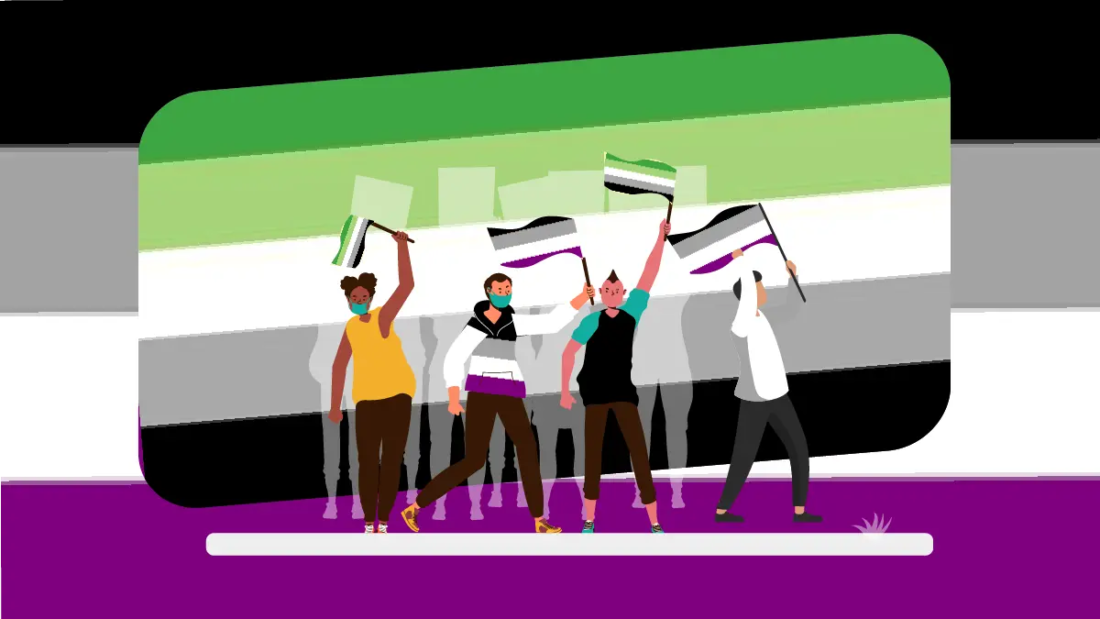February, known as the “month of love,” is commonly linked with romantic gestures and gifts among couples. Romantic love is gift-wrapped in commercialization as retail industries amplify their marketing strategies, and sales on gifts, flowers, cards, soar in February. Valentine’s Day could be a wholesome opportunity for happiness, joy, and connection through various expressions of love, yet it enshrines the glamour of romantic monogamous (often heterosexual) love as the ultimate purpose of life. No wonder then that Valentine’s month, centered on the glorification of a certain kind of romantic love, can inadvertently heighten challenges for asexual and aromantic teenagers in understanding their identities.
Since our childhoods we are conditioned to find love, get married, be consumed by sex, have kids, etc. as the prime purpose of life. This type of conditioning/prescribed way of life is known as amatonormativity. The widespread belief that finding love and settling down is the end-goal tends to prioritize romantic and sexual relationships over platonic and familial bonds. This cultural norm influences how people define their connections, allowing others to dictate these definitions. In the hierarchy of relationships, romantic love then becomes aspirational and overshadows all else.
This is the same conditioning that makes us mine for some romantic subtext in the affectionate friendships between cis men and women. In a world dominated by not only a heteronormative but amatonormative script, aromantic and asexual individuals grapple with self-discovery amid societal pressure. The enthusiastic celebration of romantic love during this time of the year intensifies struggles, as a lack of awareness about asexuality and aromanticism complicates their journey.
The challenges posed for the Aro and Ace community
Aromantic and asexual (aro and ace) individuals often face internal conflicts, feeling compelled to conform to societal norms that don’t resonate with their authentic selves. The isolation and alienation they experience highlight the importance of fostering inclusivity and awareness. During Valentine’s Week, promoting education and support networks becomes crucial, creating a more accepting society that values the diverse spectrum of identities, transcending conventional romantic expectations.
Navigating Valentine’s Week, asexual and aromantic teens find themselves questioning their “normal” behaviour in a world where romantic sentiments take center stage . The pervasive portrayal of romance in media and societal expectations leaves them feeling out of place, reinforcing the challenge of embracing their unique identities . In the shows and movies we grew up with, romantic love took center stage, sidelining the portrayal of meaningful platonic bonds. From TV to literature, the focus leaned heavily on romantic relationships, leaving little room for the exploration of friendships and family ties. This narrow lens creates a skewed perspective on love, neglecting the depth and significance found in non-romantic connections. A more inclusive approach in media representation is crucial, offering a broader understanding that encompasses both romantic and platonic dimensions. It’s time to enrich narratives by acknowledging the diverse ways we connect, extending beyond the heteronormative romantic narratives that shaped our upbringing.
The portrayal of Aro and Ace folx in pop media
This Valentine’s period also accentuates the realization that aromantic and asexual folx do not experience attraction in the same way as their peers . While their friends engage in romantic pursuits, these teens grapple with the internalised sense of difference, fostering feelings of isolation and questioning why their experiences diverge . In a world without representation and awareness, articulating their asexuality or aromanticism becomes a linguistic challenge, further complicating their interactions with others. The lack of a vocabulary to express their unique experiences contributes to frustration and a sense of being unable to truly explain themselves to those around them.
This can be seen in Heartstopper Season 2, where the asexual Isaac’s journey takes center stage. Known for his love of books, he often seeks solace in literature. As his friends embark on romantic escapades, Isaac grapples with a sense of isolation and questions his own emotions.
In a pivotal moment, Isaac confides in James about his emotional confusion. James, in his attempt to be supportive, suggests Isaac may not have found the right person yet, unintentionally amplifying Isaac’s frustration. A turning point occurs when Isaac encounters a teen artist proudly identifying as both asexual and aromantic. The show explores the nuances of these identities, emphasizing the diverse experiences within the asexual (ace) and aromantic (aro) communities.
Isaac’s friend group playfully teases him about a potential romance with James, prompting Isaac to question their fixation on romantic drama. This confrontation sheds light on the challenges faced by those identifying as asexual or aromantic within a society pressurizing adolescents to behave in a certain way.
Isaac’s moment of liberation arrives as he connects with the artist, gaining a language to articulate his identity. Heartstopper Season 2 not only presents a seldom-told story but challenges societal norms, fostering a more inclusive understanding of diverse identities, particularly those associated with the “asexual” and “aromantic” labels. It’s a compelling narrative that prompts reflection on the varied facets of love and attraction.
Misinformation around aromanticism
The broader societal misunderstanding of asexuality and aromanticism perpetuates harmful stereotypes, leading to dismissive attitudes and isolating these teens even more. Accusations of being attention seeking, particularly during a week dedicated to romantic expression, adds an additional layer of stress, invalidating their experiences and feelings.
The rejection or misunderstanding of ‘non-romantic platonic love’ contributes to the challenges faced by asexual and aromantic teens, particularly during a time centered on romantic ideals. Society’s failure to recognize diverse forms of love exacerbates this issue.
In specific cultural contexts, like Indian culture, there is a notable lack of research on asexuality and aromanticism, compounding the challenges faced by these teens. Misinformation further marginalizes them, hindering a comprehensive understanding of their experiences. On a positive note, the concept of queer platonic intimacy within the LGBTQ+ community offers an alternative. Queer platonic intimacy involves cultivating deep, non-romantic connections that challenge traditional platonic boundaries, providing individuals with safety, social belonging, and acceptance. This unique form of intimacy includes elements of mutual care, affection, and even romance, presenting an inclusive perspective on relationships.
The unique challenges faced by aro and ace teens
Even within the LGBTQ+ community, asexual and aromantic individuals may encounter exclusion and a scarcity of resources. The focus on the more known ideas of queerness can lead to neglect, heightening feelings of isolation and hindering the formation of a supportive community within the broader spectrum.
The absence of open conversations about asexuality and aromanticism leaves these teens without a support network. The fear of judgment, both from society and within the LGBTQ+ community, amplifies the risk of depression. The lack of mental health resources tailored to their unique experiences adds another layer of difficulty. In therapy, counselors may unintentionally perpetuate biases, assuming clients operate from a deficit due to their ‘lack of romantic feeling’. The risk of unnecessary cross-examination adds doubt, alienating clients and contributing to internalized shame. Affirmative therapy urges counselors to understand clients’ needs without imposing norms, emphasizing mindfulness and self-knowledge.
Aromantic and Asexual individuals grapple with a sense of social invisibility within the LGBTQIA+ community, navigating a landscape where loneliness persists despite efforts to blend in. The Trevor Project’s 2020 survey of over 40,000 LGBTQIA+ youth found that asexual kids reported higher rates of anxiety and depression than other LGBTQIA+ youth of the same age. Additionally, 13 percent of asexual youth in the survey had attempted suicide.
In this journey, AroAce people confront unique forms of oppression, contending with invalidation from family and partners based on misconceptions about their orientation. The question of changing one’s orientation parallels the struggles faced by other LGBTQIA+ individuals, with both the American Counseling Association (ACA) and the American Psychiatric Association (APA) condemning conversion therapy attempts. Psychological distress often roots in societal non-acceptance, and affirmative therapy focuses on identifying internalised biases while promoting self-acceptance. The journey entails releasing societal norms, navigating new life goals, relationships, and communication in alignment with AroAce authenticity, nurturing a process of self-discovery and growth.
Dismantling stereotypes, conducting further research in cultural contexts, and fostering inclusivity within the spectrum of sexual orientations are crucial steps toward creating a supportive environment. Raising awareness about the aro/ace spectrum within queer communities is vital. Characters like Isaac in Heartstopper contribute to the visibility of asexuality, fostering inclusivity and representation in popular media. Only through these concerted efforts can we hope to mitigate the impact on the mental health of asexual and aromantic teens during Valentine’s Week and beyond.
Did you know?
Aromantic (Aro) individuals can have meaningful relationships? Romantic relationships aren’t the only type out there. Aro people can foster deep, loving connections with friends, family, and platonic partners if they choose to.
Here’s something interesting: Some Aro folks opt for queer platonic relationships or partnerships. What’s that, you ask? Well, these are like platonic relationships but with a deeper commitment level. Think living together or sharing financial and domestic responsibilities. The catch? These relationships aren’t typically romantic or sexual in nature. Who says meaningful connections are confined to the romantic realm?
Written by Akanksha Singh (Reviewed by Usri)
 Cart is empty
Cart is empty 


